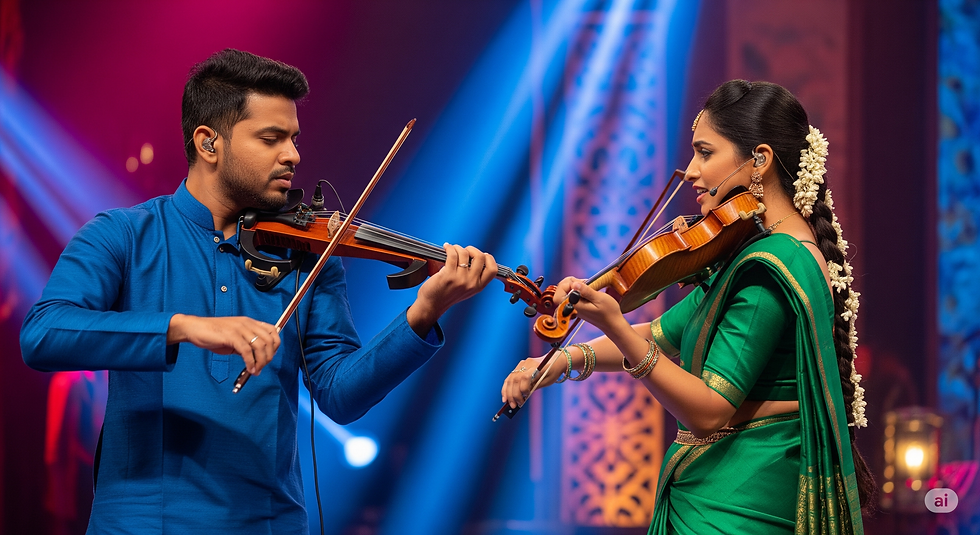"Dueling Strings: Exploring the Art of Violin Jugalbandis in Carnatic Music"
- Sharanya naidu
- Aug 20, 2024
- 3 min read
Updated: Oct 16, 2024
Introduction
Carnatic music, one of the oldest and most complex musical traditions in the world, has a rich tapestry of vocal and instrumental styles. Among its various forms, the violin occupies a significant place, not just as a solo instrument but also as part of intricate duets known as jugalbandis. These performances, where two violinists engage in a musical dialogue, offer a unique insight into the depth and versatility of Carnatic music. For music learners, studying these duets can be both an enriching experience and a key to understanding the of this classical art form.

The Role of the Violin in Carnatic Music
The violin was introduced to Carnatic music in the early 19th century by Baluswami Dikshitar, who adapted the instrument to suit the specific needs of the genre. Over time, the violin has become a central component of Carnatic music, known for its ability to closely mimic the human voice. Its versatility allows for a wide range of expressions, from the delicate to the dynamic, making it a perfect partner for vocalists and other instrumentalists alike.
What is Jugalbandi?
In the context of Carnatic music, jugalbandi refers to a duet performance where two musicians—often of equal stature—engage in a musical conversation. Unlike the North Indian jugalbandi, where the artists may come from different musical traditions, Carnatic jugalbandis are usually rooted in the same tradition, focusing on complementing and challenging each other within the same raga and tala (rhythm) framework.
The Dynamics of Violin Jugalbandi
A violin jugalbandi in Carnatic music is much more than just two musicians playing together. It is an artistic exchange where both violinists explore the contours of a raga, taking turns to lead and respond. This exchange can take several forms, including:
Raga Alapana: The initial exploration of the raga, where each violinist interprets the raga's mood and structure.
Tanam: A more rhythmic exploration, where the violinists play with intricate patterns, often challenging each other's improvisational skills.
Pallavi: The central theme of the performance, where both violinists come together to explore the raga and tala in a more structured manner.
Swara Kalpana: The exchange of swaras (notes) between the two violinists, where they push the boundaries of the raga, often engaging in complex rhythmic patterns.
Tani Avartanam: A percussion solo that offers a break and adds another layer of complexity to the performance before the violinists conclude the jugalbandi.
Learning from Jugalbandi Performances
For music learners, studying violin jugalbandis offers several benefits:
Understanding Raga and Tala: Jugalbandis provide a deep dive into the intricacies of raga and tala. By observing how two seasoned violinists navigate these frameworks, learners can gain a better understanding of the subtle nuances involved in raga exploration and tala interpretation.
Developing Improvisational Skills: The improvisational nature of jugalbandis teaches learners how to think on their feet. It encourages creativity and helps build the confidence needed to experiment within the boundaries of Carnatic music.
Learning the Art of Musical Conversation: Jugalbandis emphasize the importance of listening and responding. Music learners can develop their ability to engage in a musical dialogue, a skill that is crucial for collaborative performances.
Appreciating the Role of Harmony and Contrast: Jugalbandis showcase how two instruments can create harmony while also highlighting contrasts. This balance between unity and individuality is a vital lesson for any aspiring musician.
Conclusion
Violin jugalbandis in Carnatic music represent a rich tradition of musical dialogue, offering both performers and listeners a deep, engaging experience. For learners, studying these performances provides valuable lessons in improvisation, collaboration, and the intricacies of raga and tala. Whether you are an aspiring violinist or simply a lover of Carnatic music, the exploration of jugalbandis can deepen your appreciation and understanding of this timeless art form.
For personalized 1:1 violin lessons with top instructors, message us on WhatsApp.



Comments